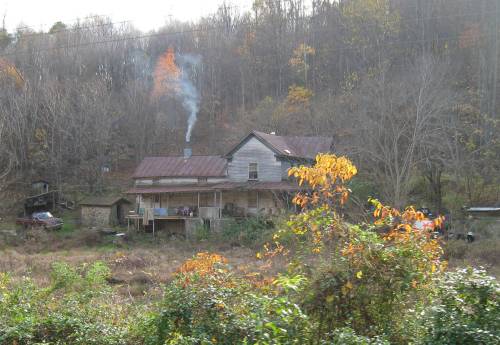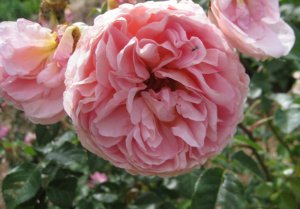 (Old home in the Blue Ridge Mountains—image by my husband, Dennis)
(Old home in the Blue Ridge Mountains—image by my husband, Dennis)
About the Granny Women: Historically, they were elderly women from ‘back in the holler’ reputed for their healing and midwifery abilities. The term is often associated with ‘Appalachia.’ However, I don’t know anyone who actually lives in Appalachia. We refer to the specific mountain ranges, the Alleghenies, the Blue Ridge, or the Smokies…but I digress. In a time and place when doctors were few or nonexistent and no one had the money to pay them anyway, the Granny Women were relied on for the wisdom and practices passed down to them by the hardy females who’d gone before them. Sure, a generous dollop of superstition and white magic was mixed in with their practical herbal remedies, but they did a lot of good. In the Shenandoah Valley and surrounding mountains, these women were invaluable. Some of my friends with deep ties in the holler (or gap) remember their family calling in the Granny Woman when they didn’t know what to do for an ailment or injury. One of them had a grandmother who was the Granny woman. Officially, these women are no longer with us. Unofficially, they are.
I recently learned more about the Granny Women after reading The Red Flannel Rag, by Peggy Ann Shifflett, a fascinating book about life in the Alleghenies. Hopkins Gap, where Ms. Shifflett grew up, is just a hop, skip, and a jump from our farm in the Shenandoah Valley, and yet, how different is the world she brings to life. Some of these customs and practices were known in the valley–still are with the real country folk–but many are unique to this more isolated mountain community. The little elementary school Ms. Shifflett describes being bussed to from Hopkins Gap is the same school my children attended, and their father before them, now replaced by a far larger modern structure. Much is gained, and lost, in our modern era. The author also happens to be the aunt of my friend, Sandy, who grew up with many of the old ways. Sandy’s widowed grandmother made moonshine to keep the family afloat, but that’s another story.
(Mountain cabin, royalty free image)
Before taking a closer look at the Granny Women, I’d assumed they mostly used herbs and other old-time remedies to cure, but they were also very into white magic. In a section of The Red Flannel Rag entitled Witches and Granny Women, Ms. Shifflett explains the widespread belief in and dread of witches among the mountain people (parts of the valley too, I add). The bad witches, she says, were just called witches and the good witches were referred to as Granny Women or Healers. These women used their powers not only to cure illness but to remove an evil spell cast by a witch. The lengths Granny women, and other fearful souls, went to in order to avoid being cursed or rid oneself of an evil spell boggles the mind. For example, when brushing your hair, or trimming a baby’s fingernails, care must be taken to collect and burn every remnant or a witch might come into your home and take these personal leavings to cast a spell on you or your infant. And if a bird were to snatch your hair and use it to build a nest, you will have a headache until you find and destroy that nest. It’s a whole other mindset.
 Ms. Shifflett describes incantations and instructions given for everything from ridding oneself of freckles on May Day to detecting and thwarting a witch. Here’s one: Make a three-pronged pitchfork red-hot and poke it through the bottom of a chair then pull it out. If at any time in the future a suspected witch sits on that chair and can’t get up, then he or she is definitely a witch. Another ploy is to lay a broom across the doorway, as though its fallen. A witch will not step across a broom to enter a house. However, it was believed they could change themselves into a snake and sliver in through the keyhole, or transform into a cat and enter through the rafters, so then you have another problem. The lore, beliefs, and superstitions among mountain people is a class in itself. Some of the treatments have practical herbal applications, but much falls into the realm of magic or faith healing. If you believed the ritual employed by a Granny woman would cure your ills or break an evil curse, then maybe it could, that whole mind/body connection thing.
Ms. Shifflett describes incantations and instructions given for everything from ridding oneself of freckles on May Day to detecting and thwarting a witch. Here’s one: Make a three-pronged pitchfork red-hot and poke it through the bottom of a chair then pull it out. If at any time in the future a suspected witch sits on that chair and can’t get up, then he or she is definitely a witch. Another ploy is to lay a broom across the doorway, as though its fallen. A witch will not step across a broom to enter a house. However, it was believed they could change themselves into a snake and sliver in through the keyhole, or transform into a cat and enter through the rafters, so then you have another problem. The lore, beliefs, and superstitions among mountain people is a class in itself. Some of the treatments have practical herbal applications, but much falls into the realm of magic or faith healing. If you believed the ritual employed by a Granny woman would cure your ills or break an evil curse, then maybe it could, that whole mind/body connection thing.
(Image of cabin in the Smokies)
 For a more in-depth exploration of the subject, read the book. I also recommend late Shenandoah Valley author and historian John Heatwole’s wonderful collection of Folklore, Tradition and Legends of the Valley entitled Shenandoah Voices. Mr. Heatwole interviewed older mountain and valley people to record this valuable resource before his death. I often refer to his collection both for the herbal lore and superstitions. Again, some are quite useful practices, others fall into the realm of fancy, unless you believe a witch can change herself into an egg and float across the stream and this worries you. Then I refer you to the time-honored ways and herbs for protection against spells. Which brings me to our next topic:
For a more in-depth exploration of the subject, read the book. I also recommend late Shenandoah Valley author and historian John Heatwole’s wonderful collection of Folklore, Tradition and Legends of the Valley entitled Shenandoah Voices. Mr. Heatwole interviewed older mountain and valley people to record this valuable resource before his death. I often refer to his collection both for the herbal lore and superstitions. Again, some are quite useful practices, others fall into the realm of fancy, unless you believe a witch can change herself into an egg and float across the stream and this worries you. Then I refer you to the time-honored ways and herbs for protection against spells. Which brings me to our next topic:
Acifidity bags: Small cloth bags worn on a string around the neck containing a mixture of chopped roots and/or spices having a strong disagreeable odor. The purpose of these bags is to ward off illness or evil. I asked my friend (mentioned above) what she remembered about acifidity bags. Sandy said her grandma (the moonshiner) made up these bags when she worried a witch had put a curse on the farm and hung them around the kids necks and put them in the hog pen to protect the pigs. Her grandma was dirt poor (likely used feed sacks to make the bags as they came in printed cotton cloth) and Sandy didn’t think she bought anything special to go in them, that she’d have filled the bags with whatever herbs she could gather, and they stunk like rotted wild onions or garlic. Children, and even pigs, wore these bags around their necks to protect them.
(Image of the Alleghenies by my husband)
Another friend, Jana, whose husband, Jerry, grew up back in Nelson County, Virginia, an extremely isolated region where they experienced a terrible flood in 1968, also had to wear these bags around his neck. Neither Jana nor Jerry remember what went into the bags, only that they stunk to high heaven to ward off anything and anyone who might cause harm to the children. There’s a pungent spice called Asafoetida, but it’s not native to the United States and has to be imported. If mountain or country women had access to a drugstore and could get asafetida, then likely that’s what they used in these bags, if not, they improvised. But I suspect the term acifidity is a corruption of asafetida, and before its introduction into America, these bags would have been called something else. Maybe just medicine or charm bags. Putting herbs, spices, or amulets into bags worn around the neck is an ancient practice.
From an article entitled: What’s in your Acifidity Bag by Bev Walker
“According to the book “Healing Spices,” asafoetida was endorsed by the US Pharmacopedia as a remedy for the 1918 Spanish Flu pandemic that killed almost 100,000,000 people globally and claimed tens of thousands of American lives per week for two years. The putrid smelling spice was stocked by pharmacies to be draped around the neck inside acifidity bags in an attempt to deflect the deadly strain of influenza. Naturally, the word “flu” struck terror in the minds of generations to follow, and the smelly cure-all medicine bags appear repeatedly throughout history whenever an outbreak of potential epidemic illness or disease occurs. Babies and school-aged children were forced to wear acifidity bags during outbreaks of polio, measles, and during the winter to stave off influenza.”
***An interesting article on Appalachian Healing Traditions



























































Interesting
LikeLike
Thanks! I thought so.
LikeLike
I so love reading these stories of Appalachia!I’m a Kentucky girl myself.My granny was what I call a dignified,sophisticated,hill woman.She had as warehouse of stories she told to me and I cherish everyone.Thank you Beth for sharing yours here.
LikeLike
Thanks so much, PJ. I’d love to hear some of your grandma’s.
LikeLike
Really enjoyed this post. Never heard of granny women before. I always learn something new.
Sue B
LikeLike
Thanks! So interesting. I loved doing this post,
LikeLike
the first image of the farmhouse with the old lady on the porch is right up the road from me…seems no ‘shine running that day since the porch has no laundry on it! all the valley residents will know what that means!!!
LikeLike
Yes, indeed.
LikeLike
pass that house every day on my way to work. seems like the laundry is out less and less these days…love the red days
LikeLiked by 1 person
Yes, me too.
LikeLike
I have collected herbs since the age of 8 with my grandfather and grandmothers, in central Appalachian in both Tenn and Ky, and at the age of 43 still love it, and the mountains and valleys that the region contains. I want to ask your aversion to Appalachia when every area you speak of, valleys, and subrange of mountains are a part of it. The wisdom and knowledge to be found from it’s northern most part to it’s soutern most is intertwined, and all parts have been, and still are related, from ridge to valley, all across this most beautiful of places, even the people who breathe in the mists that rise from it’s soil are a part of the land. We are all made stronger through this connection, and have a much better chance of preserving it by keeping it, and keeping it important. I do applaud your interest and passion for our folk ways, and qish you well and good luck in your efforts.
LikeLiked by 1 person
I have no aversion to Appalachia. We live in the Shenandoah Valley surrounded by the Alleghenies on one side, the Blue Ridge on another, and the Massanutten Mountain range up the center. I used to live near the Smokies. When people speak of Appalachia, I’m not sure exactly where we are. I like mountain names, that’s all.
LikeLike